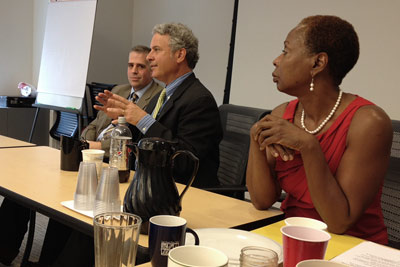Nutrition experts are dubious about NYC's large-soda ban
By Caroline Shin

You're standing at the snack counter of a movie theater deciding among 51-, 44- or 32-ounce cups of soda.
Which will you choose? And why isn't there a 16 ounce-sized option?
Cornell obesity, nutrition and food marketing experts discussed the potential effectiveness of New York City Mayor Michael Bloomberg's proposal to ban the serving of soda in containers larger than 16 fluid ounces at a luncheon for journalists July 19 at the Cornell ILR Conference Center in Manhattan.
"Consumers deserve the freedom to choose," said Louis Aronne, M.D., clinical professor of medicine and director of the Comprehensive Weight Control Program at NewYork-Presbyterian/Weill Cornell Medical Center. He remarked that in the movie theater scenario, economic incentive is stacked in the largest drink's favor. "How is this for choice?" he asked.
Increasingly, larger portions have become the social norm, the experts agreed.
"And increased portion means increased consumption," said Carol Parker-Duncanson, the lead nutritionist at Cornell Cooperative Extension-New York City, which implements community-based nutrition programs for low-income families in the city.
How can you shrink consumption down to a healthier size?
People engage in "mindless drinking," choosing from what's in front of them, said Parker-Duncanson. Consumers, she said, "are depending on the government to make the decisions that will benefit them in the long run."
She has observed that the soda ban hasn't even percolated into their conversation.
David Just, associate professor in Cornell's Dyson School of Applied Economics and Management and co-director of the Cornell Center for Behavioral Economics in Child Nutrition Programs, suggested a psychological approach to manipulating the social norm.
"We can regulate size names," he said, by "calling a beverage 'normal' as opposed to 'medium.'"
While he agreed that the problem is the inaccessibility of small beverage sizes, he remains wary of the unprecedented soda ban.
"It is a full-scale field experiment in five boroughs," Just said, expressing concern that the city had not conducted a formal research experiment prior to Bloomberg's proposal.
For one, he worries that Bloomberg's top-down approach may result in "reactance" from New Yorkers, a rebellion of sorts against the situation imposed upon them. Instead, the choice should be up to consumers to challenge the soda companies.
"What if New York City went to them and said, we want smaller sizes?" he suggested.
Furthermore, if a policy is in place to help curb obesity, as is the case at hand, it should directly target the causes of obesity -- unhealthful eating patterns and sedentary lifestyles -- and eliminating one soda choice doesn't cut it, said Just.
At the end of the day, the solution to thirst is simple, said Parker-Duncanson.
"The ultimate thirst quencher is water."
And size doesn't matter.
Caroline Shin is a freelance writer in New York City.
Get Cornell news delivered right to your inbox.
Subscribe